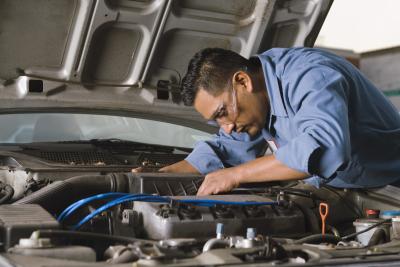
Building a fuel injector tester is a fairly easy way to both check and clean your own injectors, and those of anyone who wants to pay you to do so. This operation is fairly simple, and simply involves mimicking the stock fuel system on a test bench. The parts are pretty easy to come by, and cleaning your old injectors will probably cost less than buying new ones.
First, you'll need a fuel pump and fuel tank. Any type of pump designed for a fuel-injected car will work. Don't bother with an off-the-shelf pump designed for carbureted systems; they don't develop enough pressure to clean the injectors. Any type of fuel container will work, and doesn't need to be sealed for reasons other than safety.
The next important part is the fuel rail itself, which is the tubing that connects the fuel system to the injectors. Fuel injectors tend to be very similar within manufacturers, so the fuel rail from a V-8 Ford will probably work with any other Ford. Crossovers are common among domestic manufacturers; for instance, the fuel rail from a 1998 Chevy truck will work with the injectors from a 1988 Ford Mustang.
You'll also need a 12-volt battery charger, 20 feet of 3/8-inch rubber fuel line,16 alligator clips (or female quick-disconnects) and a good deal of 18-gauge red and black wire, a 10-gallon fish tank with a cover, and a roll-around workbench to mount it to.
Mount the fuel tank and fuel pump on the lowest shelf of your workbench, and run an outlet line from the pump to the tabletop. Install the fuel injectors you wish to test into the fuel rail, and mark the fish-tank lid where the bottoms of the injectors touch it. Drill holes into the lid that allow the fuel injectors to fit inside while attached to the fuel rail. Connect the fuel rail to the pump output line.
Run four red wires with alligator clips or female quick-disconnects from the positive terminal of your battery charger. Do the same with black wires, but wire an on/ff switch into the circuit. Wire the battery charger to the fuel pump in the same way.
First, fill the fuel tank with a 50/50 mix of injector cleaner and gasoline, and connect all of the red-wire quick-disconnects to the positive terminals on the fuel injectors. Do the same with the back wires. Put the fish-tank lid on the tank and hold the fuel rail with your hand. Turn the switches on, and fuel should begin to flow. Run your test rig until the fuel spray pattern is even and conical. Never attempt this procedure inside your garage or near an open flame.
Of course, you can refine this design further by adding a drain to the fish tank, by better sealing its lid and creating a retainer for the fuel rail itself, but none of those things are required for basic operation.